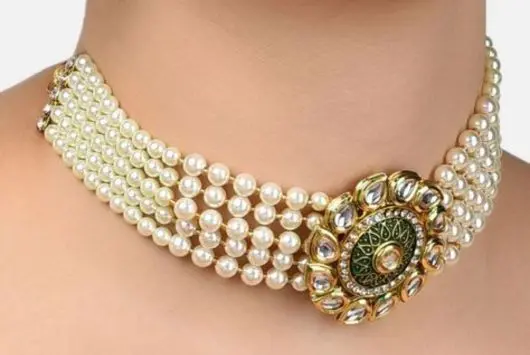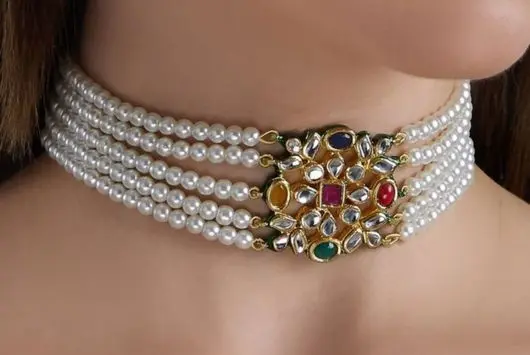PEARL JEWELRY
Pearl Jewelry specifications focus on several characteristics that determine the quality, value, and type of pearls used in the Jewelry. Below are the detailed specifications for pearls used in Jewelry:


1. Types of Pearls
Natural Pearls: Formed in the wild without human intervention; rare and highly valuable.
Cultured Pearls: Created with human assistance by inserting a nucleus into a mollusk to stimulate pearl formation. Common types include:
Akoya Pearls: Known for their high luster and classic round shape; typically white or cream-colored.
Freshwater Pearls: More affordable and come in various shapes and colors; often produced in rivers and lakes.
Tahitian Pearls: Known for their dark, exotic colors, such as black, gray, green, and blue.
South Sea Pearls: The largest and rarest type, known for their white, silver, and golden hues.
Mabe Pearls: Half-pearls formed against the shell of the mollusk, usually used in pendants and earrings.
2. Luster
Definition: The quality and intensity of light reflected from the surface of the pearl. High-luster pearls appear more radiant and valuable.
Luster Grading:
Excellent: Bright, sharp reflections with strong shine.
Good: Clear reflections, though not as sharp.
Fair: Light reflections appear more muted.
Poor: Dull and chalky surface.
3. Surface Quality
Definition: The presence or absence of imperfections such as spots, bumps, or ridges on the pearl’s surface.
Clean: Little to no visible imperfections.
Slightly Spotted: Minor blemishes that do not detract significantly from beauty.
Moderately Spotted: Noticeable imperfections that affect value.
Heavily Spotted: More visible blemishes that lower the quality and value.
4. Shape
Round: The most valuable and rarest shape, especially for Akoya and South Sea pearls.
Near-Round: Slightly off-round but still attractive.
Button: Flat on one side and domed on the other; ideal for earrings and pendants.
Oval: Egg-shaped pearls.
Baroque: Irregular and unique shapes, often used for modern and artistic jewelry.
Drop: Teardrop-shaped, popular for earrings and pendants.
5. Size
Measurement: Measured in millimeters (mm). Larger pearls are generally more valuable, especially if they have good luster and surface quality.
Typical Sizes:
Akoya Pearls: Usually range from 2mm to 10mm.
Freshwater Pearls: Commonly 4mm to 12mm.
Tahitian Pearls: Typically 8mm to 15mm.
South Sea Pearls: Usually 9mm to 20mm, with larger ones being rarer and more valuable.
6. Color
Body Color: The primary color of the pearl, which can range from white and cream to black, gold, and pastel shades.
Overtone: The subtle secondary color that appears on the surface of the pearl, such as pink, blue, or green.
Orient: A mix of colors that shimmer across the surface of high-quality pearls.
Factors Influencing Color:
Akoya Pearls: Typically white or cream with rose or silver overtones.
Tahitian Pearls: Naturally dark with green, blue, and aubergine overtones.
South Sea Pearls: White or golden with silver or pink overtones.
Freshwater Pearls: Can come in a variety of natural and treated colors.
7. Matching
Definition: Consistency in color, shape, size, and luster when multiple pearls are used in the same piece, such as necklaces and bracelets.
Matching Grades:
Excellent: Uniform in all aspects.
Good: Slight variations that do not affect the piece’s overall look.
Fair: Noticeable differences but still visually appealing.
Poor: Mixed shapes, colors, or luster that reduce the piece’s aesthetic.
8. Nacre Thickness
Definition: The layer of nacre coating the nucleus of the pearl. Thicker nacre results in better luster and durability.
Nacre Grading:
Thick: Durable and has a deep, lustrous sheen.
Thin: More prone to chipping and may have a weaker luster.
9. Pearl Jewelry Styles
Necklaces: Pearl strands come in various lengths such as choker (14-16 inches), princess (17-19 inches), matinee (20-24 inches), opera (28-35 inches), and rope (over 36 inches).
Earrings: Studs, drops, chandeliers, and hoops.
Bracelets: Single or multi-strand.
Pendants: Often feature single pearls or more elaborate settings with additional gemstones.
Rings: Pearl-centric designs often paired with diamonds or other accent stones.
10. Jewelry Metal Setting
Common Metals: Gold (14k, 18k), white gold, rose gold, and sterling silver.
Classic: Simple and elegant prong or bezel settings that showcase the pearl.
Modern: Unique, artistic settings with intricate metalwork.
11. Certification
Importance: Ensures the authenticity and quality of pearls.
Certification Providers: Trusted laboratories and gemological institutes like the GIA (Gemological Institute of America) offer detailed reports on pearl quality, size, and type.
12. Care and Maintenance
Cleaning: Use a soft, damp cloth to clean pearls. Avoid harsh chemicals and ultrasonic cleaners.
Storage: Store pearls separately from other jewelry to prevent scratching. Use a soft pouch or cloth-lined box.
Wearing Tips: Pearls should be the last item you put on and the first you take off to avoid contact with makeup, perfume, or hairspray.
